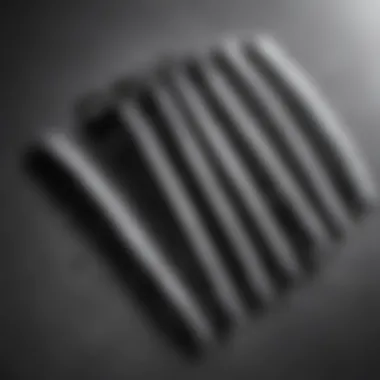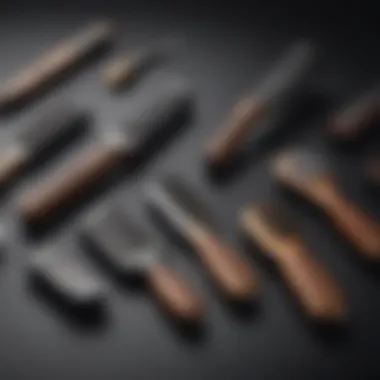Mastering Dandruff Control: Effective Combing Techniques


Intro
Dandruff is a widespread but often troublesome condition that affects many people's scalp health. Its presence can lead to itchiness, irritation, and noticeable flakes that may impact self-esteem. Understanding how to manage this condition is essential for maintaining a healthy scalp and vibrant hair. This article will outline practical techniques for effectively using a comb to manage dandruff, emphasizing proper methods every reader can adopt. Combing is not merely a styling activity; rather, it is a vital part of your hair care regimen that, when executed skillfully, can provide long-lasting relief from dandruff.
Understanding Dandruff
Dandruff results from the overproduction of skin cells on the scalp. This condition can have several underlying causes, such as:
- Dry skin
- Oily skin conditions
- Fungal infections
- Product build-up
Acknowledging these factors is vital for addressing the issue effectively. As we proceed, we will specifically discuss combing techniques tailored to mitigate these causes.
Proper Combing Techniques
The utilization of a comb requires more than just simple strokes through the hair; it demands an understanding of effective techniques. Here’s how one can comb to combat dandruff:
Slow and Methodical Movements
Taking time is key. Use slow and steady strokes to avoid irritatin the scalp. This gentle approach helps in loosening and removing flakes without causing friction that can worsen irritation.
Sectioning the Hair
Another vital technique is working through the hair section by section. This method ensures all areas are addressed. Start at the roots and move towards the tips, paying careful attention to the scalp for better results.
A well-practiced combing technique can not only reduce dandruff, but also increase blood circulation to the scalp, promoting healthier hair growth.
Choosing the Right Comb
Not all combs contribute equally to dandruff treatment. Selecting the correct type enhances effectiveness.
Some recommended types are:
- Wide-Toothed Combs: These are gentle against the scalp and ideal for detangling hair without excessive pulling.
- Fine-Toothed Combs: Best for applying treatment products evenly, but should be used carefully to avoid irritating sensitive scalps.
Equipping yourself with the right tools can significantly impact your grooming experience.
Complementary Hair Care Practices
In addition to effective combing techniques, further practices can soothe the scalp. Regular washing with a pH-balanced shampoo can help clean away excess oil and flakes. Incorporating scalp massages during washing also improves circulation. Treatment masks designed to hydrate the scalp may also prove beneficial. Always remember that consistency is crucial in achieving a healthier scalp.
The End
Managing dandruff elegantly blends proper technique and the right tools. By understanding the nuances of careful combing and integrating necessary hair care practices, achieving a healthy scalp becomes feasible for everyone. With our exploration of effective techniques laid out, readers can formulate their approaches, fortified with insights that extend beyond mere combing.
Understanding Dandruff
Dandruff affects many men, impacting their confidence and overall appearance. Understanding this condition is crucial to effectively manage and minimize its impact. Dandruff can appear due to various reasons, and recognizing these factors helps create a tailored approach to care. Familiarity with its effects and root causes enables informed decisions about products and combing techniques.
Definition and Symptoms
Dandruff is the shedding of dead skin cells from the scalp. It often results in visible white or yellow flakes. These flakes can be embarrassing and lead toitching, which can distract from daily life. Men with dandruff might observe flakes on their shoulders or in their hair, affecting their self-image.
Symptoms of dandruff are evident. Flaky patches on the scalp appear alongside itchiness. In severe cases, it may develop a redness or inflammation, signaling irritation. These signs indicate a need for attention to minimize both physical discomfort andvisual concerns.
Common Causes
Dandruff has several common causes that contribute to its formation. Understanding these triggers allows one to change habits or products. They include:
- Dry Skin: Particularly during winter months, dry air causes scalp dryness, leading to flaking.
- Oily Scalp: An excess of oil can cause an overgrowth of yeast, which leads to dandruff.
- Irritated Skin: Reactions to hair products or skincare products can result in scalp irritation and flaking.
- Seborrheic Dermatitis: This skin condition causes red, oily patches along with large flakes.


Identifying personal causes and motives is fundamental to controlling dandruff problems. Logical evaluation of one’s habits can mitigate these issues significantly.
Types of Dandruff
There are mainly two types of dandruff recognized by professionals. Being aware of these variants allows individuals to distinguish their conditions and determine appropriate remedies.
- Dry Dandruff: Characterized by fine, dry flakes results from lack of moisture in the scalp. This type is more prevalent in colder months when skin overall tends to become drier.
- Oily Dandruff: This variant presents larger, greasy flakes that can be associated with an oily scalp. It usually requires different therapeutic approaches for relief.
Awareness of these types can guide which products are more appropriate to use. By considering one’s scalp type, targeted strategies can lead to more effective outcomes.
Understanding the fundamentals of dandruff serves as the first step in addressing its underlying causes and symptoms effectively. Knowledge is the first aspect of regaining control over not only dandruff but also overall hair health.
The Role of Combing in Dandruff Management
Combing plays a significant role in the management of dandruff. Effective combing techniques can alleviate symptoms, improve scalp health, and enhance the overall appearance of hair. It is not just about removing flakes but creating a conducive environment for healthier hair growth. Understanding the importance is essential to anyone looking to combat dandruff effectively.
How Combing Helps
Combing can help manage dandruff in various ways. First, it can exfoliate the scalp. Regular combing sweeps away dead skin cells, preventing them from accumulating and forming flakes. It also stimulates blood circulation, which is essential for a healthy scalp. Improved blood flow delivers nutrients to hair follicles, potentially promoting stronger hair growth.
Moreover, when you comb your hair, you may inadvertently spread natural oils from the scalp along the hair shaft. This oil distribution can mitigate dryness, contributing positively to scalp hydration. Additionally, combing can help in distributing anti-dandruff treatments or oils evenly over the scalp and hair, maximizing their effectiveness.
Effective combing cultivates an environment where both hair and scalp can thrive.
Understanding Your Scalp
To achieve success in tackling dandruff through combing, you need to be aware of your scalp's characteristics. Every individual’s scalp can vary greatly: some might be oily, while others are dry. This aspect influences how often you should comb and the techniques to use.
For example, if your scalp is oily, it may require more regular combing to balance the oiliness. On the other hand, a dry scalp may necessitate gentler combing methods to avoid irritation. Understanding these needs leads to more effective combing methods tailored to condition of your scalp.
It is advisable to examine your scalp frequently. Look for signs of irritation, redness, or itching, which could indicate an underlying issue that goes beyond just dandruff. Knowing the state of your scalp can assist in determining the right combing techniques and any complementary products you may want to incorporate into your routine. By fine-tuning your combing approach to match your scalp's requirements, you not only combat dandruff but also enhance your overall hair care strategy.
Choosing the Right Comb
Selecting the appropriate comb is critical in the battlefield against dandruff. Not all combs work at the same level. Different designs and materials cater to various needs and scalp conditions. Choosing wisely can optimize the effectiveness of combing treatments. A proper comb can help maintain your hairstyle and promote overall scalp and hair health.
Types of Combs
There a variety of comb types that serve unique purposes. Each has its own pros and cons. Knowing these differences can assist in making the right choice:
- Wide-Tooth Combs: Ideal for untangling wet hair. They minimize breakage and are gentle on the scalp, making them excellent for daily use.
- Fine-Toothed Combs: They are more effective for styling and smoothing. However, they might irritate the scalp, especially for those with dandruff.
- Teasing Combs: These have close-set teeth and can create volume. But they should be used sparingly to avoid scalp damage.
- Round-Tipped Combs: Specifically designed for sensitive scalps, the rounded tips lessen friction and irritation while combing.
Understanding these types will improve the efficiency of your dandruff management routine.
Material Considerations
Material matters when picking a comb for dandruff. Combs can differ significantly in how they interact with hair and the scalp:
- Plastic Combs: Commonly used; affordable and lightweight but can generate static. This might lead to further flaking of dandruff.
- Metal Combs: Offer durability and firmness. However, they can become very cold and may irritate sensitive scalps.
- Wooden Combs: These are gentle on hair and may help in distributing natural oils evenly. They may reduce static and help keep dandruff at bay. Plus, they have a natural aesthetic appeal.
Take the time to consider which material aligns best with your hair and scalp needs.
Tine Spacing and Length
Tine spacing and length will affect how efficient your comb is. Choosing the right specifications for your comb may significantly impact the outcome:
- Wider Spaced Tines: Suitable for thicker and coarser hair. They can move through the hair with ease and avoid pulling or causing pain.
- Narrow-Spaced Tines: Best for fine textures and smoothing looks, yet may aggravate dandruff if there’s too much pulling.
In addition, longer tines can forage through dense sections of hair, while shorter ones might suit precise sections. Analyze your hair type when selecting the comb’s tine properties.
Choosing the right comb is more than just aesthetics. It is a central part of a practical strategy to combat dandruff effectively.


Techniques for Effective Combing
Properly managing dandruff involves more than mere cosmetic solutions. It requires a well-thought-out approach that includes effective techniques for combing. Understanding how to employ combing to reduce dandruff could make significant positive changes to the health of one's scalp.
Regular combing plays a critical role in removing dead skin cells and product buildup from the scalp. These elements can exacerbate dandruff. Furthermore, combing helps distribute natural oils from the scalp along the hair shaft, promoting hydration and sheen. Over time, these practices contribute to a balanced scalp environment, which in turn can help reduce the frequency and severity of dandruff outbreaks. Practicing effective combing techniques quickly distinguishes regular procedures from an effective routine. Now let's dive into particular aspects of effective combing.
Daily Combing Routine
Establishing a daily combing routine often sounds simple but requires dedication and consistency for effectiveness. The timing of this routine matters. Many find morning or evening sessions ideal, coinciding with personal grooming habits. Aim to comb gently to avoid irritating the scalp, which can cause further flaking.
- Select the appropriate tool: A wide-tooth comb usually works best in the morning. This helps detangle hair with minimal breakage.
- Cleanse your tools: Ensure that the comb used is free of buildup to avoid transferring additional bacteria and oils onto the scalp.
- Technique & patience: It is pivotal to start at the tips and work upwards. Then finally finish combing at the roots, ensuring ample circulation to your scalp.
Above all, taking this time to integrate combing into your daily routine nurtures a positive routine to managing scales and facilitates absorption of any scalp treatments you might employ.
Comb Direction and Pressure
Recognizing the significance of comb direction and pressure is vital in optimizing the benefits that combing can render. Most individuals might not give this much thought during their routine tasks. This lack of awareness could play a role in aggravated dandruff or irritation over time.
- Direction matters: Always comb starting from the scalp toward the ends of the hair. This method stimulates the scalp's blood circulation and loosens flakes moved from beneath your hair.
- Pressure considerations: Apply gentle pressure while moving the comb through the hair. Too much force can lead to breakage and irritation. Focus on a soft surface that ensures base health.
Incorporating these simple measures can immensely enhance the efficiency of everyday combing, transforming an ordinary act into an effective remedial measure against dandruff.
Handling Tangled Hair
Tangles are just another challenge on the pathway to healthy hair and scalp. Effective handling can reduce frustration and improve the outcome of combing sessions. An appropriate strategy for approach is essential in navigating such frustrations while avoiding exacerbating dandruff further.
- Don’t rush: Begin at the tips with your comb allotted before tackling larger sections. Patience is pivotal here as pulling on tangled spots can result in irritation of the scalp.
- Utilize a conditioner: Consider applying a leave-in conditioner designed for detangling before combing. This softens the hair and aids in the combing process.
- Dissolve bigger tangles with fingers first: Gently work fingers through severe tangles prior to reaching for a comb. Utilizing a rely on hands helps limit fierce pulling that may induce scalp discomfort.
In resolving the common associated difficulty of tangled hair, combing becomes an effective and less detrimental practice as complaints regarding dandruff are reduced.
Effective combing techniques can play a significant role in managing dandruff, improving scalp health, and enhancing overall grooming routines for those struggling with persistent issues.
By focusing on these combing techniques, the relationship between methodical combing and healthier hair and scalp survives. Efforts invested into such routines will yield noticeable improvements in the long term. Understanding this process is fundamental for men interested in mastering fashion, style, and, more importantly, self-care.
Complementary Hair Care Practices
Effective management of dandruff needs more than just combing techniques. It involves a holistic approach to hair car and scalp health. Complementary hair care practices can substantially reduce the occurence of dandruff while nurturing your hair. Focusing on these practices can make tarateh differences.
Shampooing Techniques
The way you shampoo your hair may seem straightforward, but there are optimal methods to consider. First, always use warm water. It helps to open the pores on your scalp. This allows impurities and dead skin cells to wash away easily.
- Choose a mild shampoo that is suited to your hair type.
- Apply shampoo gently, massaging it into your scalp using your fingertips. Avoid using your nails, as they can irritate your scalp.
- Rinse thoroughly. Any residue can lead to buildup, aggravating dandruff.
Consider opting for anti-dandruff shampoos on a regular basis if you experience frequent troubles, but ensure that they do not excessively dry out your scalp.
Conditioning Products
Conditioners add moisture to your hair but they also play a role in scalp health. A well-moisturized scalp can lead to fewer flakes. While using products, consider the following:
- Use a conditioner that contains ingredients like aloe or chamomile, particularly beneficial for sensitive skin.
- Apply conditioner primarily to the hair ends, rather than directly onto the scalp. Overloading your scalp with heavy product can lead to additional buildup.
- Allow the conditioner to sit for the recommended time to absorb and then rinse clean.
Improving your conditioning routine can help maintain scalp health, directly or indirectly influencing the reduction of dandruff symptoms.
Regular Scalp Exfoliation
While often overlooked, regular exfoliation of the scalp can help by removing dead skin and product buildup. Here are some insights:
- Use specialized scalp scrubs or create a simple scrub with brown sugar mixed with your conditioner.
- Gently massage to encourage blood flow and loosen flakes while cleansing the skin.
- Exfoliate every couple of weeks, paying attention to any signs of irritation.
Combining this practice with your combing and washing routines creates a comprehensive path to maintaining your scalp’s health.


Incorporating complementary hair care practices into your routine can be integral for managing dandruff and ensuring healthy hair growth.
In summary, addressing the topic of complementary hair care practices matters significantly in tackling dandruff and enhancing scalp wellness.
When to Seek Professional Help
It is important to know when to seek professional help regarding dandruff treatment. Dandruff may seem like a minor issue, but in some cases, it could signify underlying scalp conditions that require medical attention. Understanding your symptoms and recognizing when they escalate can not only help alleviate discomfort but also guide you to the appropriate care options swiftly.
Signs of Severe Dandruff
Several signs indicate a transition from minor to severe dandruff. It is crucial to pay attention to these warnings:
- Persistent Flaking: If flaking continues despite home treatments for more than a few weeks, it might be time to consult a specialist.
- Severe Itching: Intense itching can cause prolonged scratching, which may harm the scalp and worsen symptoms. This becomes an indicator of a more aggressive scalp issue.
- Scalp Redness and Inflammation: If your scalp appears red or inflamed, it could signal an infection or another scalp condition.
- Oily or Dry Scalp: An unusually oily or dry scalp, accompanied by dandruff, may necessitate medical evaluation.
- Discoloration and Discomfort: Discomfort while touching or styling your hair may also showcase deeper underlying issues.
Most people overlook mild dandruff, but when these symptoms appear, timely professional input is vital for proper treatment.
Possible Treatments from Dermatologists
When visiting a dermatologist, various treatment options may be proposed, depending on the severity of dandruff and underlying conditions:
- Medicated Shampoos: Dermatologists often recommend specialized shampoos containing active ingredients such as ketoconazole, zinc pyrithione, or coal tar. These compounds aim to target fungal growth and alleviate symptoms effectively.
- Topical Steroids: In cases of strong inflammation and irritation, a doctor might prescribe topical steroids to reduce redness and swelling.
- Antifungal Creams: For persistent cases that are linked to fungal infections, antifungal creams may provide welcome relief.
- Light Therapy: Some dermatologists might suggest light therapy, which uses specific wavelengths of light to combat inflammation and scalp issues.
Recognizing when conventional measures are insufficient is essential. Professional expertise can save time and not only improve symptoms but also maintain your overall scalp health. This approach enables men passionate about fashion and style to maintain an exemplary appearance and healthy scalp condition.
Maintaining Long-Term Scalp Health
Maintaining a healthy scalp is crucial in managing dandruff and preserving the overall condition of your hair. Long-term scalp health is not merely a matter of aesthetics; it impacts comfort, confidence, and personal style. Neglect can lead to chronic issues such as severe dandruff, irritation, and potential hair loss. Therefore, it becomes vital to look at the habits we develop for scalp care and how they contribute not only to our hair's appearance but also to our scalp's well-being.
Lifestyle Changes
Incorporating specific lifestyle changes can contribute significantly to optimal scalp health. These changes may require an adjustment in daily habits but can yield benefits over time.
- Stress Management: High stress can exacerbate dandruff. Practices such as meditation, yoga, or regular physical activity can help in reducing stress levels.
- Adequate Sleep: Quality sleep allows the body to repair itself. Lacking sufficient sleep can disrupt scalp health by affecting hormone levels, potentially contributing to flakiness.
- Hygiene Routines: Regular scalp hygiene plays a crucial role. This includes not over-washing but maintaining a balanced routine that supports natural oils while eliminating excess buildup.
- Monitoring Hair Products: Using suitable products free from harsh chemicals greatly benefits scalp health.
- Hydration: Drinking enough water helps keep the scalp hydrated, supporting its natural balance.
Dietary Influences
Diet has a considerable impact on scalp health. The nutrients consumed reflect not consistently in our physical health but also the condition of our scalp. Here are aspects to consider regarding diet:
- Fats and Omega-3 Fatty Acids: Incorporating healthy fats found in fish such as salmon or flaxseeds helps maintain scalp moisture.
- Vitamins and Minerals: Important nutrients, such as iron (found in spinach, red meat), vitamin B (like found in whole grains), and zinc (from nuts and seeds), support the regeneration of scalp skin cells. Digest a variety of fruits and vegetables for optimal vitamin intake.
- Avoid Processed Foods: These can increase inflammation and lead to scalp irritations. Focus more on whole foods which offer numerous vitamins and minerals.
- Balancing Sugar Intake: High sugar consumption could contribute to inflammation, influencing the severity of dandruff.
Maintaining health requires attention in many areas of life. When considering one's scalp health, combining effective techniques for combing with lifestyle and dietary habits is important. By recognizing the role of these dimensions together, achieving healthier hair and a healthier scalp is more attainable.
Culmination
In addressing the pervasive issue of dandruff, it is crucial to encapsulate the significant insights covered throughout the article. All complexities of scalp health and effective combing techniques converge here to present a coherent approach for management. Understanding dandruff—its causes, types, and manifestations—offers a foundation from which individuals can formulate strategies.
Key pointers emphasized in this discussion entail a variety of combing techniques tailored for optimal results. Selecting the right comb, while maintaining a regular care routine, remains non-negotiable aspects of an efficacious dandruff combat plan.
Equally, complementary hair care practices further enhance the practical outcomes of these techniques. By adhering to proper shampooing, conditioning, and scalp exfoliation, not only can dandruff be countered, but overall scalp health is also significantly improved. The psychological and aesthetic dimensions of having healthy hair and scalp cannot be undermined, as they contribute to one's self-confidence and public perception.
HoIistic scalp care is not only a remedy but also a means to promote well-being.
Investment in knowledge regarding dandruff allows readers to navigate various products and practices more effectively. Thinking critically about individual scalp conditions ensures tailored approaches yield better results and sustained improvements over time.
Recap of Key Points
- Dandruff stems from various factors ranging from dry skin to underlying dermatological conditions.
- Regular and gentle combing can help minimize dandruff by dusting off flakes and distributing natural oils from the scalp.
- Choosing the right comb—whether it be plastic, metal, or wood—is essential in preventing additional scalp irritation.
- Incorporating a daily combing routine enhances effectiveness, and attention to combing direction matters.
- Complementary practices of using quality shampoos and conditioners, as well as treating the scalp with regular exfoliation, support long-term relief.
Encouragement for Ongoing Care
Maintaining a diligent scalp care routine can set the stage for long-lasting benefits. Men looking to enhance their style effortlessly can merge these suitable habits into being well-groomed. As dandruff can fluctuate with seasons and personal habits, continuous vigilance is recommended.
Regular assessments of one's grooming products ensure they remain effective. Monitoring dietary choices can also play a significant role, with nutritional components potentially minimizing flakes.
Implementing a consistent regime over time uplifts not just appearance, but self-esteem as well. Engage with community forums, such as those on reddit.com, to remain updated on personal experiences from others battling similar issues. ليس النظام الحالي آمنا يعني صر بمستحيل عودة.
Ultimately, a proactive stance on managing dandruff will pay dividends, leading to healthier hair, improved aesthetic, and greater overall confidence.















